
DH Illustration
There have been several developments in the health tech sector, with wearables and other health-tracking devices becoming all the rage, especially post-Covid-19. Dr Tony Raj, Dean, St John’s Research Institute (SJRI), sat with DH's Udbhavi Balakrishna, to talk about the work the institute is doing in this realm, some of its national and international collaborations, and challenges he foresees in the health industry. Excerpts:
What are some recent national collaborations that SJRI has been a part of for digital health interventions?
We have engaged with the Government of Karnataka as part of the Vision Group for Technology along with other institutes and have contributed to the vision document. We are also engaging with the state government and community health officers from various districts to train them to use a new application for mental health being developed by the ICMR as part of a multicentre study.
We have just received three grants from ICMR under the banner of the Centre for Advanced Research for five years. One such grant is for medical devices, of which five are innovations of our own. One is for a patch to record preterm babies’ body temperature, and another is a device for paediatric nephrology.
We also received a grant from the Biotechnology Industry Research Assistance Council (BIRAC) two years ago to develop a prototype of a left ventricular assist device which will act as a pump to push blood inside the heart in case of a heart attack or failure.
Are there any international collaborations or studies expected shortly?
We have developed an application for detecting depression in collaboration with the University of Washington on a pilot mode in Anekal taluk. This was used in self-help groups. We received a grant from the National Institutes of Health (NIH), in the United States, to develop this application and conduct a pilot study. Under the Point-of-Care Technologies Research Network by the US government, we received a significant grant last year along with Cornell University to evaluate and validate medical devices.
What are some developments and challenges you see in the space of medical devices such as wearables over the next decade?
Medical devices are the next big thing in India. But, I think there has been an overwhelming increase in the number of devices that have come into the market. Most of these consumer devices might not be validated against gold standards. They should be made engaging and persuasive to make sure people sustain these habits. While there is a big medical device usage boom in a certain socio-economic class, digital and health literacy of the masses along with increasing compliance is a big challenge. Persuasive technology is an area we need more research on; there is a lot of scope for work. Engineers, software groups, and the health fraternity need to work together to design applications keeping the end user in mind.
You might recall the ICMR data breach that occurred last year. How do we ensure we strengthen systems to protect our health records?
If the data is anonymised and cannot be identified or retraced to patients, personal data is protected and encrypted. If it is a notifiable disease, that information has been mandated to be fed to the government in an anonymised manner. If privacy by design is incorporated into the system, there will be no markers or identifiers to connect patients to their health information. Additionally, the National Digital Health Blueprint has proposed a federated architecture for data storage. It proposes that people can consent for only specific records to be shared among hospitals under certain conditions while the data remains in the primary centre. As a country, our design of such databases needs to mature.
What are some recent projects done at the cross-section of health and technology?
We have been looking at childhood obesity, which is a huge problem. Our nutrition division has been following children from birth to their teenage years to explore how some of them move towards becoming chronic patients in the future. We have done cross-sectional studies where we have observed school children and followed up on them over three or four years to look at the influence of various factors in the development of childhood obesity. We also have set up a whole-body potassium counter and are using it to study pregnant women’s body composition and tissue mass, and also the infant’s tissue mass soon after birth.
You have conducted studies that link yoga to insulin sensitivity. Please elaborate on that.
About two decades ago, we were doing some experiments to measure insulin sensitivity, which refers to how one’s body cells respond to insulin. The gold standard to measure insulin sensitivity is the glucose clamp technique. We decided to look at yoga practitioners and see how they compared with sedentary adults. We found that their insulin sensitivity was much higher. They were just practising yoga for 10 years, nothing strenuous. So, the message for the public is to do some kind of exercise to keep their insulin sensitivity up.